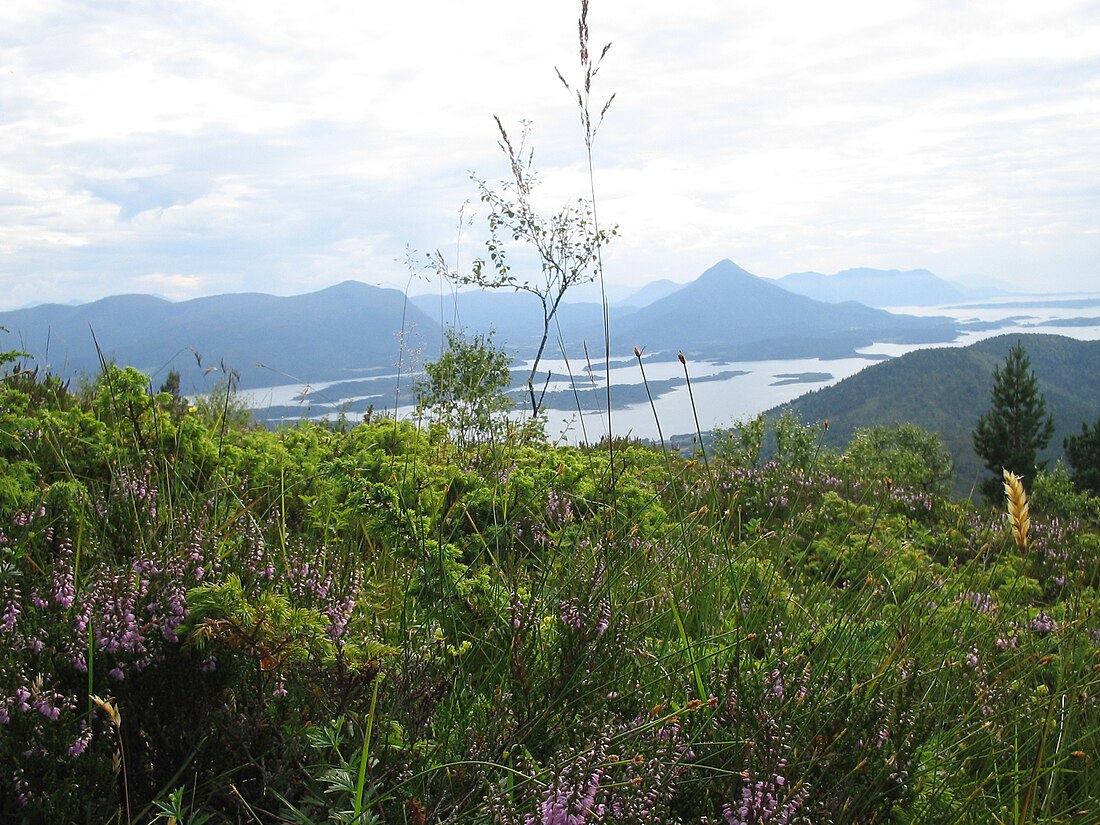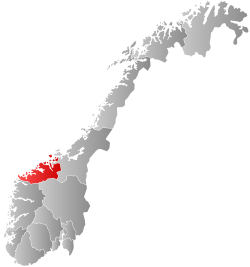Top Qs
Timeline
Chat
Perspective
Fræna Municipality
Former municipality in Møre og Romsdal, Norway From Wikipedia, the free encyclopedia
Remove ads
Fræna is a former municipality in Møre og Romsdal county, Norway. The 370-square-kilometre (140 sq mi) municipality existed from 1840 until its dissolution in 2020. The area is now part of Hustadvika Municipality in the traditional district of Romsdal. The municipality was located on the Romsdal peninsula surrounding the Frænfjorden, the eastern shore of the Julsundet strait, and it included most of the Hustadvika area. It also included the now-abandoned Bjørnsund islands.
The main village and administrative centre in Fræna was Elnesvågen. Other villages in Fræna included Hustad, Bud, Tornes, Sylte, Malme, and Aureosen. Moxy Engineering, Hustad Marmor, and Tine Meierier are all factories located in Elnesvågen.
Prior to its dissolution in 2020, the 370-square-kilometre (140 sq mi) municipality was the 250th largest by area out of the 422 municipalities in Norway. Fræna Municipality was the 115th most populous municipality in Norway with a population of about 9,800. The municipality's population density was 26.5 inhabitants per square kilometre (69/sq mi) and its population had increased by 5.9% over the previous 10-year period.[5][6]
Remove ads
General information
Summarize
Perspective


The municipality of Fræna was established in 1840 when it was separated from Akerø Municipality. Originally, it was named Vaagø Municipality and it surrounded the Frænfjorden. Later the name was changed to Fræna Municipality.[7]
During the 1960s, there were many municipal mergers across Norway due to the work of the Schei Committee. On 1 January 1964, Bud Municipality (population: 1,610), Hustad Municipality (population: 2,196), and Fræna Municipality (population: 3,430) were merged to form a new, larger Fræna Municipality.[7]
On 1 January 2020, Eide Municipality and Fræna Municipality were merged to form the new Hustadvika Municipality.[8][9]
Name
The municipality (originally the parish) was first named Vaagø, after the old Vaagøen farm (Old Norse: Vágøy) since the first Vågøy Church was built there. The first element is vágr which means "bay" or "sea". The last element is øy which means "island".[10] The municipality had this name from 1840 until 1865. In 1865, the municipal name was changed to Frænen, after the Frænfjorden (Old Norse: Fræni). The meaning of the fjord name is unknown, but it may have been derived from the word frænn which means "bright" or "shiny". Another option was that it comes from the word frenje which means "foam" or "howl", referring to the local fjord in high winds.[11] On 3 November 1917, a royal resolution changed the spelling of the name of the municipality from Frænen to Fræna.[12]
Coat of arms
The coat of arms was granted on 15 May 1995 and it was in use until 2020 when the municipality ceased to exist. The official blazon is "Or, three bars wavy azure crested to the dexter on the upper edge" (Norwegian: På gull botn tre blå bjelkar der overkantane er teikna med kvervelsnitt). This means the arms have a field (background) has a tincture of Or which means it is commonly colored yellow, but if it is made out of metal, then gold is used. The charge is three horizontal bars designed too look like ocean surface waves. The arms were chosen to symbolize the municipality's connection to the sea. There are three bars to represent the three former municipalities which were merged to form Fræna Municipality in 1964: Fræna, Bud, and Hustad. The arms were designed by Jarle Skuseth. The municipal flag has the same design as the coat of arms.[13][14][15]
Churches
The Church of Norway had four parishes (sokn) within Fræna Municipality. It is part of the Molde domprosti (arch-deanery) in the Diocese of Møre.
Remove ads
Geography

The municipality of Fræna was located on the northwestern end of the Romsdal Peninsula. The Norwegian Sea was to the north; the Harøyfjorden, Julsundet strait, and Aukra Municipality were to the west; Molde Municipality was to the south; and Gjemnes Municipality and Eide Municipality were to the east.
The Frænfjorden cut into the middle of the municipality. The coastal areas were low and marshy while the interior of the municipality was mountainous. The highest point in the municipality was the 981.4-metre (3,220 ft) tall mountain Kvannfjellet.[1] Other notable mountains in Fræna were Jendemsfjellet, Høgheitinden, and Lågheiane. The Bjørnsund islands were located off the northwestern coast of Fræna. They are now uninhabited, but the Bjørnsund Lighthouse is still in operation.
Remove ads
Government
Summarize
Perspective
While it existed, Fræna Municipality was responsible for primary education (through 10th grade), outpatient health services, senior citizen services, welfare and other social services, zoning, economic development, and municipal roads and utilities. The municipality was governed by a municipal council of directly elected representatives. The mayor was indirectly elected by a vote of the municipal council.[16] The municipality was under the jurisdiction of the Frostating Court of Appeal.
Municipal council
The municipal council (Kommunestyre) of Fræna was made up of 31 representatives that were elected to four year terms. The tables below show the historical composition of the council by political party.
Mayors
The mayor (Nynorsk: ordførar) of Fræna was the political leader of the municipality and the chairperson of the municipal council. The following people have held this position (incomplete list):[34]
- 1840–1845: Knut Pedersen Haukaas[35]
- 1859–1860: Christen T. Sommernæs[36]
- 1869–1875: Arne Stavik[37]
- 1876–1876: Ingebrigt Rødseth[38]
- 1877–1877: K. Julset[39]
- 1878–1878: Ingebrigt Rødseth[40]
- 1879–1881: O. Julset[41]
- 1882–1883: O. Sande[42]
- 1884–1893: Ole Brogstad[43]
- 1893–1910: Peder Jonsen Malmedal[44]
- 1910–1922: Mathias Hoemsnes[45]
- 1922–1928: Knut A. Ødegaard[46][47]
- 1928–1934: Iver Olsen Kjørsvik[48][49]
- 1934–1937: Hans Haukås (NS)[50]
- 1937–1940: Iver Olsen Kjørsvik[49]
- 1945–1945: Iver Olsen Kjørsvik[49]
- 1945–1946: Ole Valle
- 1947–1963: Harald J. Stavik (Ap)[51]
- 1963–1975: Sverre Moen (KrF)[52]
- 1975–1979: Hans Kvadsheim (Sp)
- 1979–1987: Knut Nilsen Sæbø (KrF)
- 1987–1999: Lindy Eidem (Sp)
- 1999–2003: Ragnar Valle (Sp)[53]
- 2003–2007: Arve Hans Otterlei (FrP)
- 2007–2011: Kjell Lode (KrF)
- 2011–2015: Nils Johan Gjendem (FrP)
- 2015–2019: Tove Henøen (Sp)
Remove ads
See also
References
Wikiwand - on
Seamless Wikipedia browsing. On steroids.
Remove ads





